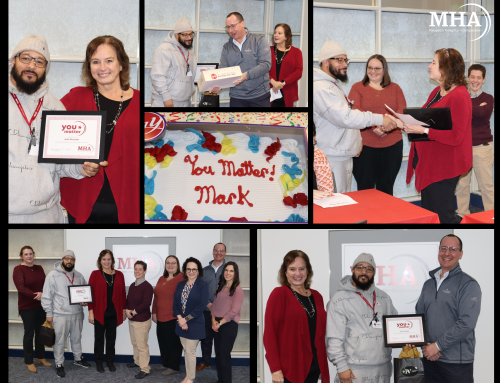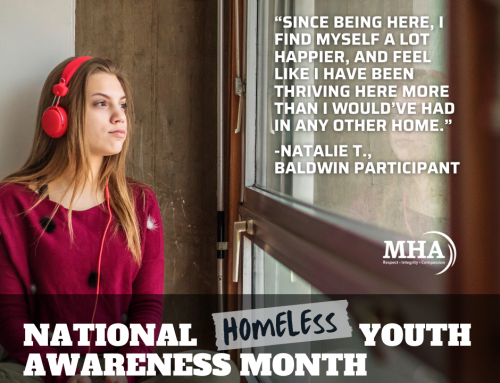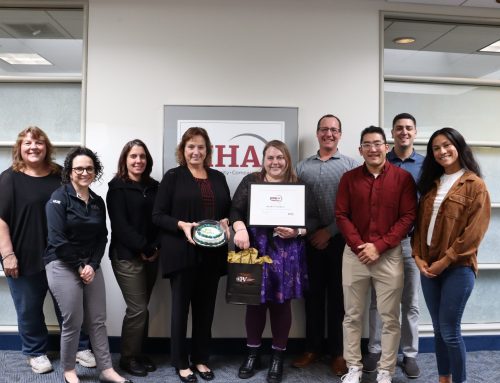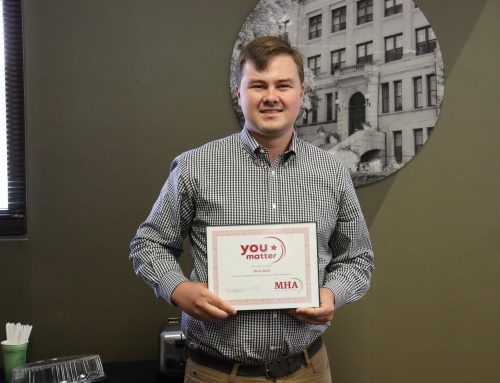Brain Injury Awareness Month is observed every March and the current theme is “More Than My Brain Injury.” It is a message embedded in MHA’s Resource Center since it opened three years ago.
The day program is part of MHA’s New Way Division for individuals whose severe physical and cognitive impairments are the result of a brain injury acquired after birth from trauma or a medical condition. The center is designed to help participants improve both mental and physical function and be able to interact with peers while engaging in activities they enjoy and often suggest.
Some of the most popular engagements are the ones presented for an hour each Wednesday by Tiffany O’Hearn, a nutrition and functional breathing coach, who has introduced members to eating choices that are healthy and easy to make as well as using their breathing to reduce stress.
“I’ve always been passionate about nutrition and fitness,” said Tiffany who wanted more work-life balance than she found in the corporate world several years ago after having her daughter. She developed an interest in how therapeutic and specialized breathing exercises, like those advocated by Wim Hof and Patrick McKeown, can be done to increase energy and calm emotions, and decided to become certified in that area as well as in nutrition education and behavior-change coaching.
She added that her work coaching MHA members, who are focused on building more skills for independence, is to show that they can have “mindful health and wellness” in their life.
She added in her presentations, particularly around breathing more functionally through the nose rather than the mouth, that she “relies on a lot on humor.”
“If you can make someone laugh, there is an automatic trust and they can identify with you,” Tiffany said. “When I go to the Resource Center, the first question I always ask is, ‘Who’s Breathing?’”
“There is not a soul alive who would not benefit from breathing better,” Tiffany said. “When we breathe more functionally, a lot of the benefit has to do with our emotions. When we focus on the breath, we bring ourselves back home.”
She added, “One of the breathing exercises I do with the members of the Resource Center is also sensory so, as you take your breath in, you trace up the thumb of one hand with the index finger of the other hand and then as you exhale, you trace down the thumb and you repeat this through the fingers.”
“The calmness that comes over the entire room by doing this gets everyone to look more inward and when we consciously breathe it helps us settle into our own body and regulate our nervous system,” Tiffany said.
Her “Discovering Wellness” presentations at The Resource Center have included a six-week course on both honoring eating choices made without guilt and the willingness to move behavior away from consistently eating the least healthy food on a continuum, such as a peanut butter cup, toward the healthiest at times, such as a scoop of natural peanut butter with a few chocolate chips.
Recently, she introduced and had everyone make simple fruit smoothies as a healthy and inexpensive alternative to foods with additive sugar, and banana ice cream which she described as “slightly thawed, cut-up pieces of frozen banana blended.”
“My MHA clients are not as capable and able bodied and this has humbled me a bit as a person,” said Tiffany of her work with individuals pushing hard against the limitations of their disabilities. “It has changed how I think about things in terms of seeing how they have to adapt, but I try to empower them to understand we all have choice in life and they still have choice though it may look a little different for them now.”
The members in MHA New Way Division have the support in their community residences of professional direct care staff and visits by clinicians and registered nurses, and Tiffany is asked sometimes asked to coach a member one-on-one having a hard time changing eating habits to improve a chronic medical condition.
“I am a different lens to come and look in and say maybe this is not supporting you best or maybe we can try some different things,” said Tiffany who provides educational material around a balanced meal to members and a binder of recipes to help with selections. “Sometimes a large roadblock in making a healthier choice for a meal is not having the ingredients for it or a recipe to make sure it comes out tasting as good as expected. The next is addressing why, if someone has the foods they need, they make other choices. We can break down the why, but it is a very slow process. You can’t change everything in day.”
She added, “Nutrition is a hard area to work with as it is so personal.”
“When you are talking about nutrition it is a very sacred space because we rely, identify with nutrition and commiserate over what we eat and hold memories around it,” Tiffany said. “When you are changing someone’s nutrition, most of the resistance has to do with an emotional set point. I want the individual to understand I am not taking something away, that there is balance in life and there has to be balance for health and wellness.”





